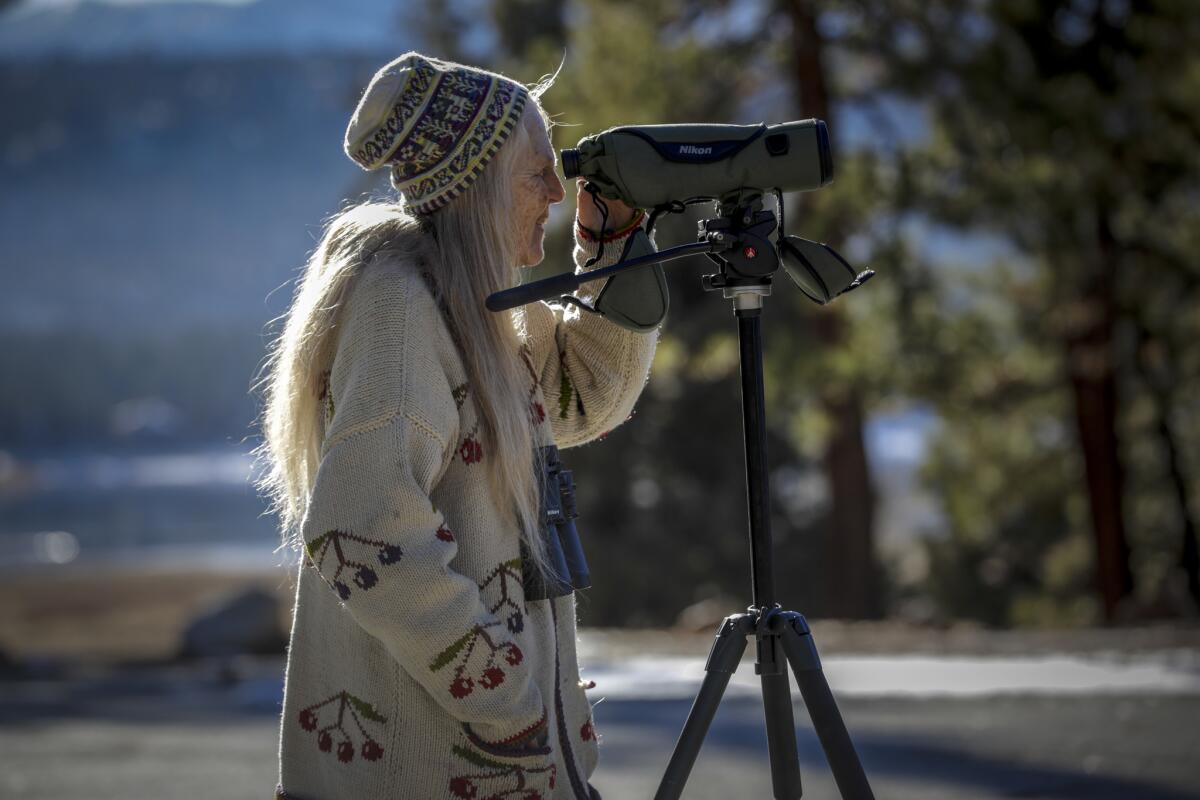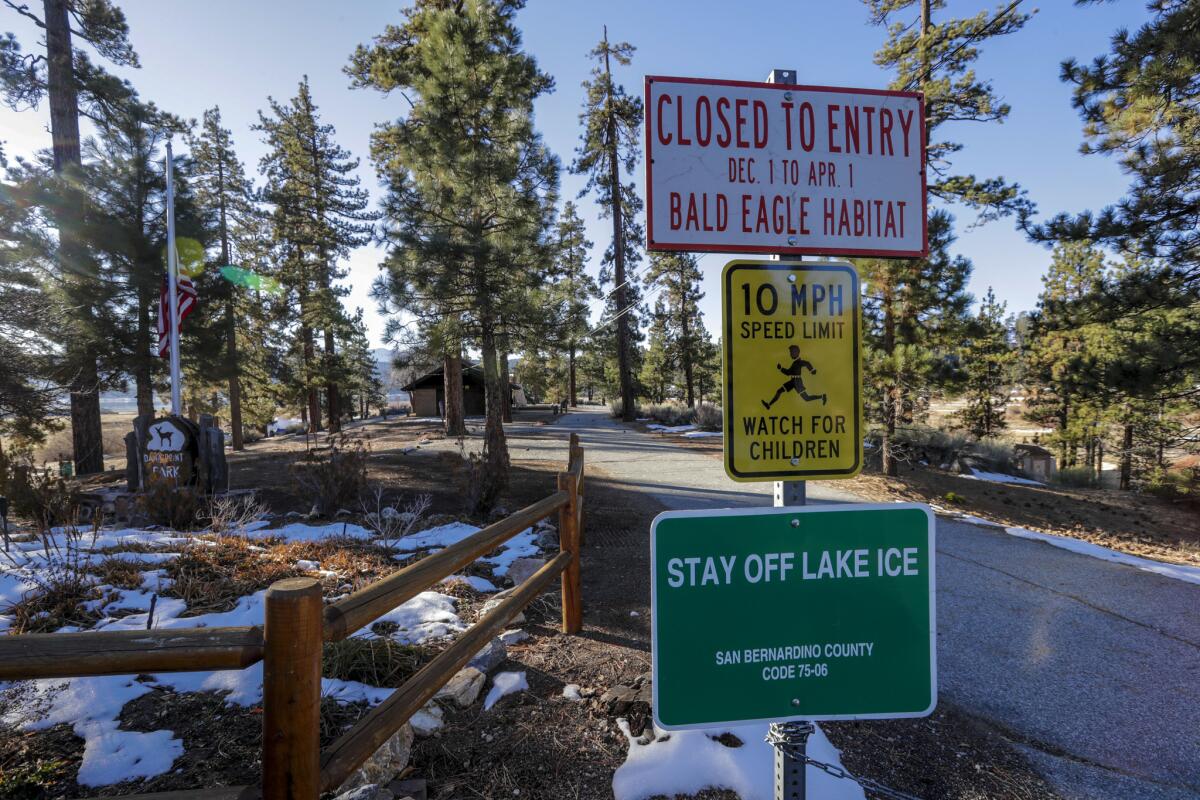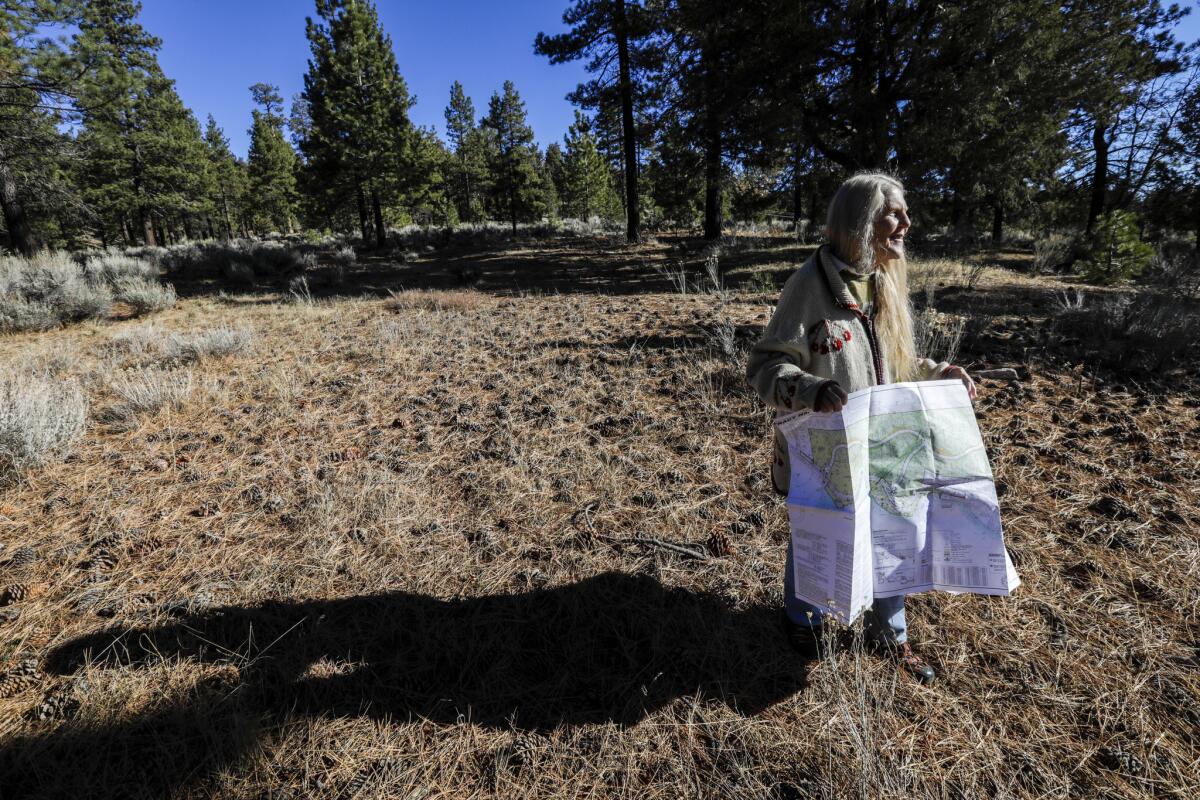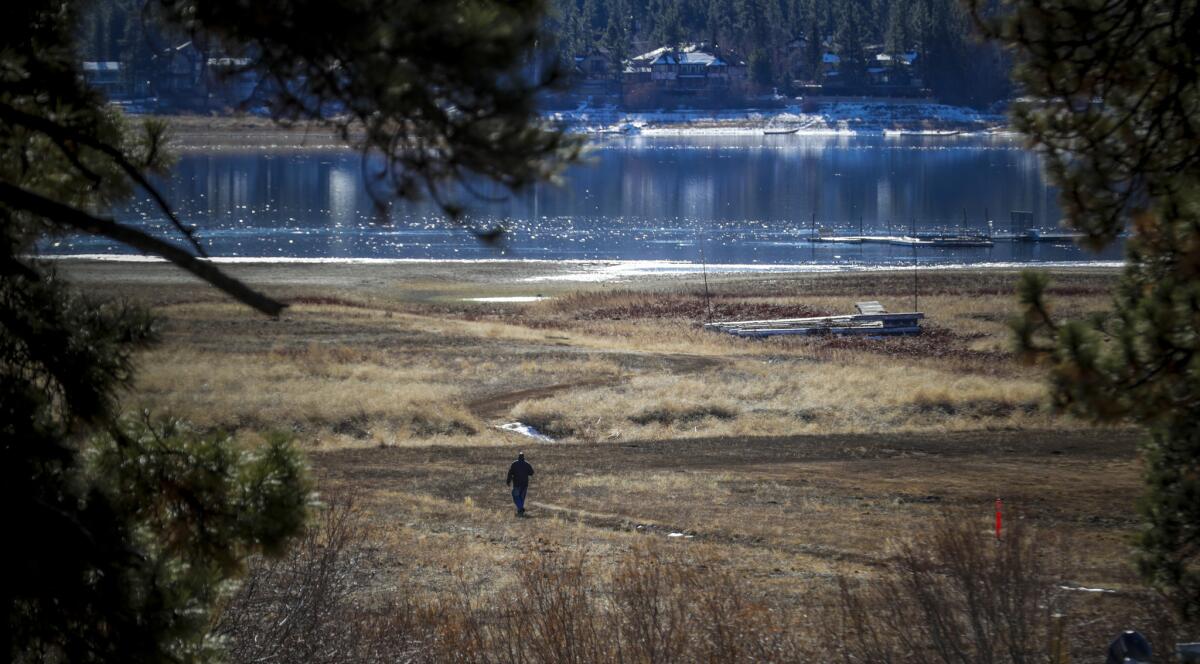Big Bear Lake is home to a growing tourist economy and a small band of bald eagles. But for how long?
Reporting from BIG BEAR LAKE, Calif. — Tourists driving bumper-to-bumper up the mountain for a weekend in the snow. Bald eagles perching in scraggly pines and swooping down to feed on fish.
Both are staples of Big Bear Lake — for now.
But as the tourist economy grows and development spreads in this San Bernardino Mountains town, bald eagles find themselves cornered in what remains of their historic lakefront foraging grounds.
The number of state-endangered bald eagles that migrate here each winter to roost and hunt has dropped at least 66% from an average of 25 three decades ago. Critics blame the decline on the increasing clatter of human activities at one of Southern California’s most heavily used lakes, which attracts about 7 million people who annually spend an estimated $350 million.

The situation has triggered a raging debate in the rustic hamlet of Fawnskin on the lake’s sparsely developed north shore, where one of the last parcels of undeveloped lakefront property is the focus of an ambitious subdivision proposal that is testing the resolve of San Bernardino County policymakers to preserve the area’s natural resources without infringing on property rights and commerce.
It is where RCK Properties Inc. of Chicago wants to build Moon Camp: 50 custom homes overlooking a private 50-slip marina on 62 acres it purchased in 1969. The county planning commission in October approved the project’s environmental review and recommended its construction despite opposition from local environmental groups and the commissioner who represents the Fawnskin area.
The tension was palpable during an annual bald eagle count on Saturday as volunteers with binoculars and notepads took stock of the cherished raptors that have thwarted numerous proposals to urbanize Fawnskin’s forested slopes.
At a high-altitude resort, where officials say two-thirds of the existing 20,000 residential units are second homes and short-term rentals, Sandy Steers, executive director of the nonprofit Friends of Big Bear Valley, wondered aloud: “Do we really need more vacation rentals?”
Michael Perry, a spokesman for RCK and a former city manager of the city of Big Bear Lake, dismisses such talk as an exaggeration of the $10-million Moon Camp project’s potential impacts.
To hear him tell it, Moon Camp’s lots have what he likes to call “unique cachet value” and will be snapped up as soon as they hit the market.
“Moon Camp is truly special,” he said. “We believe there are lots of people in Los Angeles and Orange counties who would love to build a home on the last undeveloped lakefront parcels at Big Bear Lake.”
The San Bernardino County Board of Supervisors will make a final decision next year. In the meantime, a separate long-delayed 110-unit luxury condominium development in Fawnskin, called Marina Point, is awaiting an appellate court ruling that could allow it to proceed.
Marina Point generated headlines in 2005 when state and federal authorities ordered a San Diego developer to drop a federal racketeering lawsuit that accused three Forest Service employees of using a small local environmental group led by Steers as a “racketeering enterprise” to block the development.
The suit was filed after a federal judge issued a preliminary judgment against the project in response to a legal challenge filed by the Center for Biological Diversity and Steers’ nonprofit Friends of Fawnskin, which has since changed its name to Friends of Big Bear Valley.
The groups accused the developer of operating without permits required by federal wildlife authorities and the Clean Water Act, and alleged that explosive growth on the lake’s southern shore had forced the region’s shrinking eagle population to congregate on the opposite side near Fawnskin.
Big Bear Valley’s bald eagle population has fallen to about eight today, U.S. Forest Service officials said. Yet they remain a draw for tourists, environmental activists and U.S. Forest Service officials, who regard them as local celebrities.
In 2012, the first recorded non-migratory bald eagle chick in the San Bernardino Mountains hatched in a Fawnskin nest. Five years later, people around the world watched via an online eagle-cam as two more chicks hatched in that nest.

Critics fear Fawnskin could lose its bald eagles as well as its mix of hodgepodge A-frame homes and cheap rentals along narrow, unlighted mountain lanes adjacent to U.S. Forest Service land.
That’s because Moon Camp is seeking a change from the rural zoning of one house per 40 acres to urban zoning of one house per 20,000 square feet. Such a move, they say, would open the way for similar zoning shifts throughout the area.
“I say keep the eagles,” said Vincent Ward, 50, a retired structural engineer who moved to Big Bear Valley four years ago. “Until I came here, I only saw bald eagles on television and in magazines. Now, they’re flying near my home. That’s remarkable.”
But for Richard Ortiz, 62, owner of Fawnskin’s tiny North Shore Cafe, the proposed development projects can’t come soon enough.
Gazing out a cafe window at Highway 38, the lonely main drag through town, he shook his head and said, “I’m 100% for growth here. And I don’t believe wildlife would go away because of it. Heck, I’ve got a bobcat homesteading on the roof of my restaurant.”
Facing opposition from a number of environmental groups including the San Bernardino Valley Audubon Society and the Center for Biological Diversity, RCK has significantly downsized its Moon Camp proposal.
The current design precludes development on the eagles’ lakefront hunting grounds, and sets aside several acres of property as a preserve for federally endangered plants, including the ashy-gray paintbrush. In addition, the developer has agreed to share water from private wells on the property with the city of Big Bear Lake’s Department of Water and Power.
Moon Camp would also require a novelty in Fawnskin: fire hydrants and sprinkler systems.
Richard Minnich, a fire ecologist at UC Riverside, suggested those upgrades may not be enough to defend against a catastrophic wildfire in a village with only two ways in and out.
Former planning commissioner Paul Smith, who was still on the panel when it approved Moon Camp’s construction in October, would not go that far.
But he was always uneasy about the Moon Camp proposal, he said, because it seemed there had not been “an adequate study done on its impacts on the sustainability of the bald eagles’ food supply.”
“But what influenced me most,” he said, “was a deeply moving plea made during a public comment period by a young woman who grew up in these mountains.”

Vanessa Valdez, 18, who was born in Lake Arrowhead, was a little nervous as she went to the podium. But that changed once she started to speak.
“I don’t get excited to see all the cars, or all the houses or all the businesses in commercialized Big Bear,” she told the commissioners. “We don’t need more houses. We have enough. I know this,” she said, “because my family cleans 20 houses a day or more” each day in the area.
“I get excited when I see the wildlife, the beautiful pines and the lake,” she said, adding that she will never forget the sight of bald eagles overhead during a third-grade field trip in the Fawnskin area.
“I plan to have children someday,” she added. “And I want to be able to show them the beauty of the animals and the trees and the lake and the landscape.”

More to Read
Sign up for Essential California
The most important California stories and recommendations in your inbox every morning.
You may occasionally receive promotional content from the Los Angeles Times.











